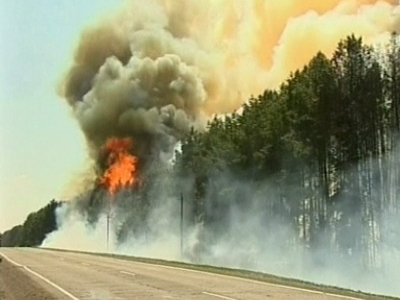Siberia ablaze: Raging forest fires engulf five Russian regions

RT,
10
October, 2017
Siberian
cities are cloaked in smoke from raging wildfires whipped up by
winds. The blazes are raging in five regions, covering an area over
22,200 acres (90 square kilometers).
The
situation is hampered by extreme temperatures. And though all flights
in the regional city of Omsk have been grounded by the blaze,
firefighters say it poses no threat to populated areas or industry.
Thick
smoke is holding back containment work and is preventing the
emergency planes and helicopters from reaching the worst-hit areas.
Some
3,000 people, 412 units of fire-fighting equipment and 24 aircraft
have been mobilized to fight the blazes.
Around
34 wildfires have been identified. Weather forecasters say hot and
dry weather with temperatures of up to 35 degrees Celsius will remain
until at least August 5.
Earlier
authorities were forced to close two airports in the cities of Tomsk
and Omsk, due to heavy smoke and poor visibility.
Ecologists fear this year’s blaze might become real catastrophe
And
while the local authorities claim they have the situation under their
control, Greenpeace ecologists are convinced that though summer fires
have become commonplace in Russia’s Siberia and Far East, this year
it is a real catastrophe.
‘If
the situation is going to develop like it is doing right now, this
year will see a record large area affected by fires,”Greenpeace
activist in Russia Maksim Yaroshenko told Radio Svoboda (Russian
Branch of Radio Free Europe).
His
colleague Grigory Kuksin also is convinced that people are unable to
deal with the blaze and only rain could possibly extinguish the fire,
even though all of the emergency workers are called in.
The
ecologists believe the reasons for the catastrophe lie in the
country’s inability to fight wildfires due to calamitous changes in
legislation. Forest management has become gravely dilapidated since
2000, when the Federal Forestry Service was liquidated.
A
new and highly ineffective Forestry Code introduced in 2006 appeared
to be the last straw. It abolished centralized state forest control,
distributing its functions among regional authorities. The latter, as
a rule, are unable – or unwilling – to allocate enough
finance to forestry protection and monitoring.
From
2006 to 2010, the number of forestry employees shrank by half. Now it
is unclear who bears responsibility for prevention and battling
wildfires.



I sometimes write neat stuff, consider following https://thenewblogsp.blogspot.com/
ReplyDeletestrange that it will sytay 35°C till 5 August
Deletecuz it was published by RT on July 21.
Deletepublished by RT July 29 2012 twentytwelve!
Delete